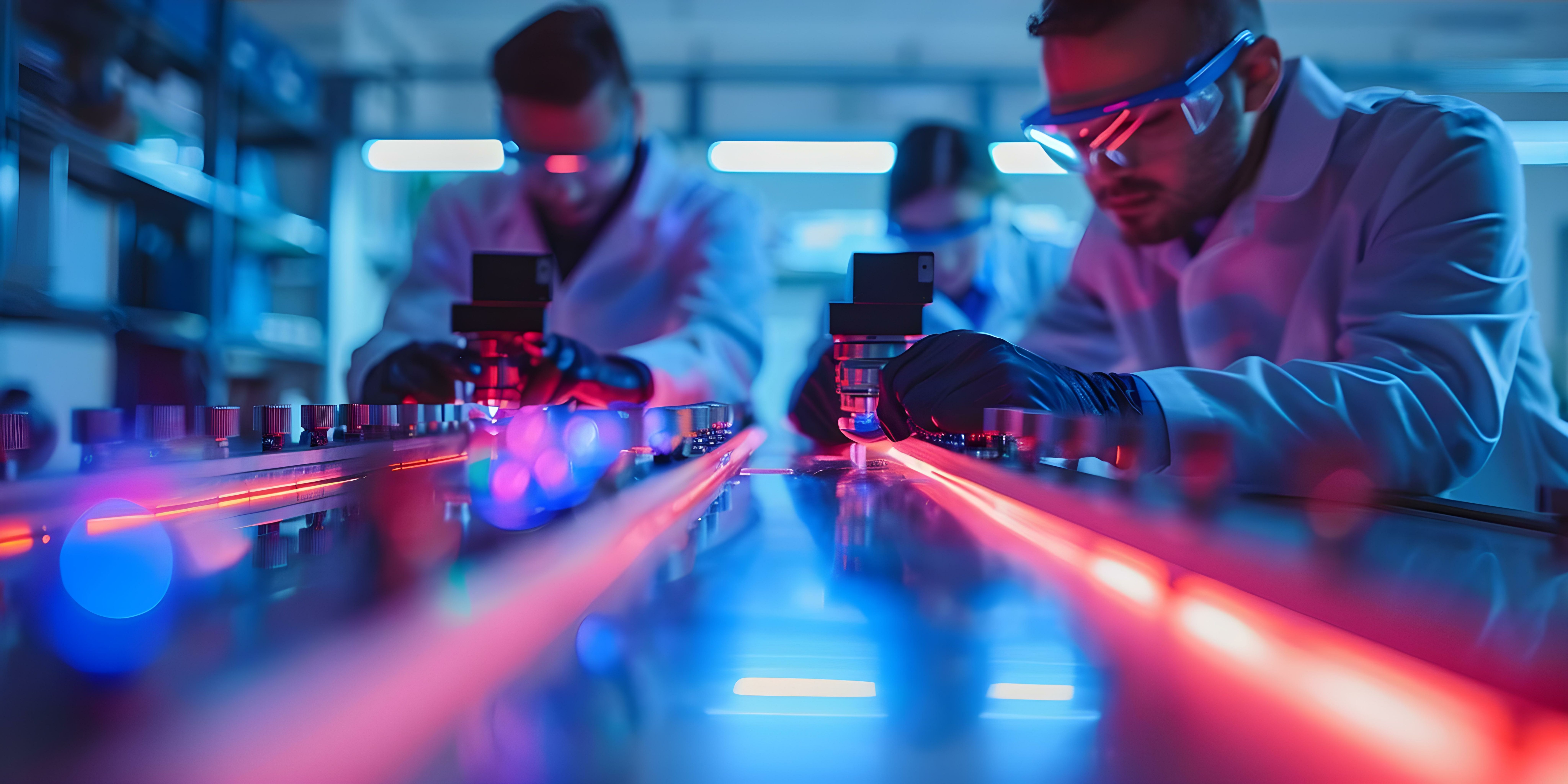An Inside Look at Recent Studies Using LIBS
A compilation of recent studies that used laser-induced breakdown spectroscopy (LIBS) as part of the experimental procedure are presented.
Laser-induced breakdown spectroscopy (LIBS) is an important atomic spectroscopy technique used in a variety of industries. As a result, LIBS is currently being used in unique and effective ways across applications such as forensic analysis, agriculture, and environmental analysis. Below is a compilation of recent studies that used LIBS as part of the analysis. Happy reading!
Quantum optics lab with lasers photon detectors and scientists conducting experiments. Concept Quantum Optics, Lasers, Photon Detectors, Scientists, Experiments. Generated with AI. | Image Credit: © Anastasiia - stock.adobe.com

Next-Gen Mineral Identification: Fusing LIBS and Raman Spectroscopy with Machine Learning
A recent study conducted by researchers from Zhejiang A&F University highlights a new approach to mineral identification using fused laser-induced breakdown spectroscopy (LIBS) and Raman spectroscopy with machine learning. This new method proposed in this study combines molecular and elemental data to accurately distinguish between different mineral types (1). By applying techniques like t-distributed stochastic neighbor embedding (t-SNE) and machine learning models such as partial least squares–discriminant analysis (PLS-DA) and kernel extreme learning machine (K-ELM), the system achieved classification accuracies of up to 98.4% across six mineral types (1). This integrated approach simplifies analysis, enhances efficiency, and holds promise for broad applications in geology and mineral exploration.
Compact LIBS Sensor Modernizes Crime Scene Forensics
This study presents a new LIBS sensor for forensic analysis. Conducted by researchers from ENEA and Fraunhofer ICT, the study demonstrated how this portable sensor enabled on-site, highly sensitive chemical analysis without extensive sample preparation, and it demonstrated precision when analyzing forensic samples like soil, fingerprints, and gunshot residue (2). The sensor's depth profiling capability allows detailed examination of layered materials, such as automotive paint. With a user-friendly interface and real-time data integration, the LIBS sensor reduces contamination risks, enhances crime scene investigations, and has potential applications in environmental monitoring and cultural heritage preservation (2).
A system combining laser-induced breakdown spectroscopy (LIBS) and a back propagation (BP) neural network (NN) was developed to analyze and trace crop-burning smoke. In this peer-reviewed article, smoke from three types of crop straws (rape seed, corn, sesame) are examined, detecting heavy metals like Fe, Mn, Sr, and Ba in the emissions (3). The BP neural network was trained on normalized spectral data, achieving 86.67% prediction accuracy for identifying the source of combustion (3). This approach demonstrates the potential of LIBS and BP methods for rapid, in situ air quality monitoring and tracing crop-burning emissions, offering a promising tool for environmental management and pollution control (3).
Evaluating the Impact of ICP-MS and LIBS on Environmental Monitoring
A recent review in Journal of Analytical Atomic Spectrometry highlights key advancements in environmental and geological analysis driven by spectroscopy. Tire particles, a significant pollution source, are now studied using unmanned aerial vehicles (UAVs) for remote air sampling (4). Inductively coupled plasma–mass spectrometry (ICP-MS) enables single-particle analysis, offering detailed insights into air pollution. Innovations like magnetic nanoparticles in flame atomic absorption spectroscopy (FAAS) and single-chamber laser-ablation LIBS enhance trace metal detection and plant analysis (4). Green chemistry trends emphasize sustainable reagents, while improved digestion and preconcentration methods benefit soil and geological studies (4). Microanalytical techniques and new reference materials (RMs) improve isotopic analyses, complemented by specialized software for streamlined data processing, advancing environmental research (4).
Boosting Deep-Sea Mineral Exploration with LIBS
This recent study shows how LIBS is being used in deep-sea exploration. LIBS analyzes light emitted from laser-induced plasma to detect elements, but its sensitivity decreases under deep-sea high-pressure conditions (5).
Lanxiang Sun's study enhanced LIBS performance using high-pressure helium gas to replace water on sample surfaces, improving spectral signal detection at 60 MPa pressure (5). Their approach demonstrated the ability to use LIBS for marine research while supporting efficient resource detection (5).
References
- Workman, Jr., J. Next-Gen Mineral Identification: Fusing LIBS and Raman Spectroscopy with Machine Learning. Spectroscopy. Available at: https://www.spectroscopyonline.com/view/next-gen-mineral-identification-fusing-libs-and-raman-spectroscopy-with-machine-learning (accessed 2024-11-13).
- Workman, Jr., J. Compact LIBS Sensor Modernizes Crime Scene Forensics. Spectroscopy. Available at: https://www.spectroscopyonline.com/view/compact-libs-sensor-modernizes-crime-scene-forensics (accessed 2024-11-13).
- Shen, L.; Tian, L.; Tian, D.; et al. Laser Induced Breakdown Spectroscopy Combined with a Tuned Back Propagation Algorithm for Oil Crop Straw Combustion Smoke Detection and Traceability. Spectroscopy 2024, ASAP. https://www.spectroscopyonline.com/view/laser-induced-breakdown-spectroscopy-combined-with-a-tuned-back-propagation-algorithm-for-oil-crop-straw-combustion-smoke-detection-and-traceability
- Wetzel, W. Evaluating the Impact of ICP-MS and LIBS on Environmental Monitoring. Spectroscopy. Available at: https://www.spectroscopyonline.com/view/evaluating-the-impact-of-icp-ms-and-libs-on-environmental-monitoring (accessed 2024-11-13).
- Wetzel, W. Boosting Deep-Sea Mineral Exploration with LIBS. Spectroscopy. Available at: https://www.spectroscopyonline.com/view/boosting-deep-sea-mineral-exploration-with-libs (accessed 2024-11-13).
Laser Ablation Molecular Isotopic Spectrometry: A New Dimension of LIBS
July 5th 2012Part of a new podcast series presented in collaboration with the Federation of Analytical Chemistry and Spectroscopy Societies (FACSS), in connection with SciX 2012 — the Great Scientific Exchange, the North American conference (39th Annual) of FACSS.
New Multi-Spectroscopic System Enhances Cultural Heritage Analysis
April 2nd 2025A new study published in Talanta introduces SYSPECTRAL, a portable multi-spectroscopic system that can conduct non-invasive, in situ chemical analysis of cultural heritage materials by integrating LIBS, LIF, Raman, and reflectance spectroscopy into a single compact device.